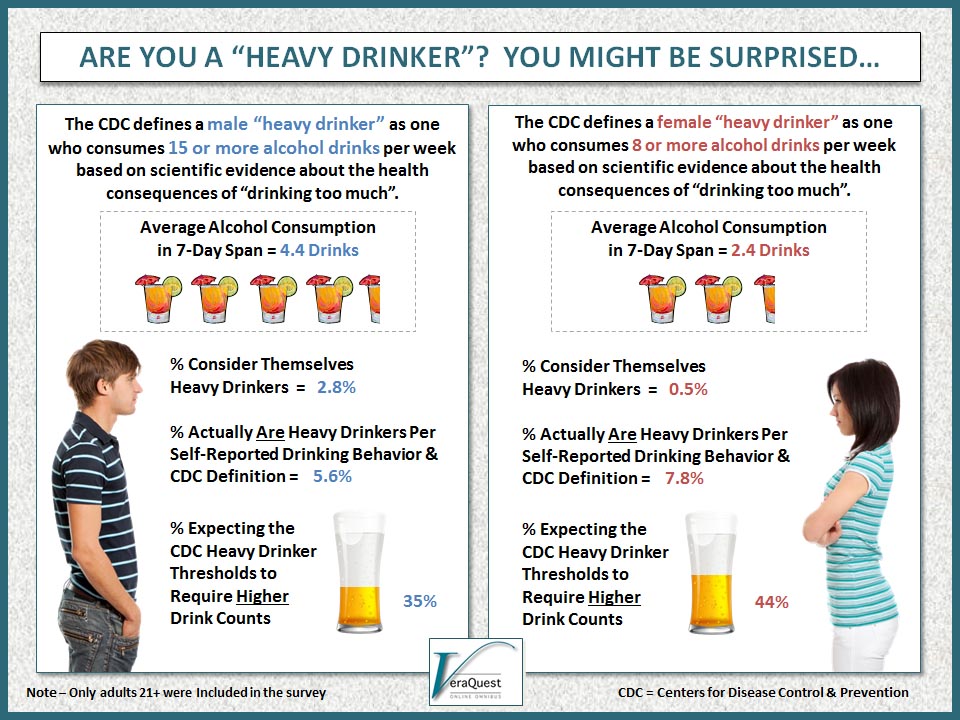Those who know me well know that I like to enjoy a single malt scotch every now and again (Oban is my favorite, in case anyone needs gift ideas). That said, I’m an infrequent drinker. I do have friends who have a glass of wine with dinner every night, and that doesn’t seem atypical to me – nor does it seem problematic. In fact, I’ve read that it’s potentially even good for you. It appears there may be a very fine line, however, especially for women.
Recently I saw an article explaining how the CDC defines a “heavy drinker” – females who consume 8+ alcohol drinks per week or males who consume 15+ alcohol drinks per week. These definitions are based on the health consequences of “drinking too much”. I was particularly surprised by the low threshold for women. A woman who partakes in the common “one glass of wine per night with dinner” dictum is on the verge of being a “heavy drinker” according to the CDC. In fact, if she springs for two glasses on a Saturday night, she has crossed over into “heavy drinker” territory. But I have to remind myself that this isn’t indicative of the CDC being all “judge-y” – it’s reportedly based on the health consequences involved, so that’s important to keep in mind.
I wanted to get Americans’ reactions to the CDC’s definitions, so we included questions on a recent VeraQuest omnibus survey. But first we gathered some behavioral data and gauged self-perceptions for background.
On average, Americans say they consume 3.4 alcohol drinks in a typical 7-day span. For men, it’s 4.4 drinks, while women consume 2.4 drinks, on average, over the same span. Before seeing the CDC’s definitions, only 1.6% of Americans considered themselves to be a “heavy drinker”. But more than 4 times that amount (6.6%) are actually heavy drinkers, based on their reported weekly drinking behavior and the CDC’s definitions. Only 16% of CDC-classified heavy drinkers see themselves as heavy drinkers.

Heavy drinkers are not the only ones with this misconception though. Overall, many Americans (40%) thought that the CDC’s “heavy drinkers” definition would be higher than the 8+ (females)/15+ (males) thresholds that they are using. Another 40% thought the definitions were similar to what they would have expected. Only 20% thought the drink thresholds would have been lower than 8+/15+. Perhaps driven by their own “8+ drinks/week” threshold (which seems low, to me anyway), women (44%) were more likely than men (35%) to say that they expected the “heavy drinkers” definition to require higher drink counts.
So what do Americans intend to do with this knowledge of the CDC’s “heavy drinker” definitions? While, overall, the vast majority (78%) do not plan to change their alcohol consumption levels, about one-in-five (21%) say they do plan to reduce the amount of alcohol they consume in a typical week. The impact is greater among CDC-classified heavy drinkers, however, as 41% of this group say that they intend to reduce their alcohol consumption.
Are you surprised by the CDC’s “heavy drinker” definitions for men and women? Does the fact that those definitions are based on potential health consequences make you more likely to keep those thresholds in mind when consuming alcohol beverages?
 Lisa says
Lisa says
September 11, 2014 at 3:15 pmHi, a comment on the CDC definition of heavy drinking: I noted the phrase “health consequences involved” a few times in your article describing your research, but I would be interested to know what those health consequences are prior to being asked whether I thought the definition was in line or not. And do the consequences break into categories by quantities, such as health consequences for drinking 8-12 drinks per week, or 12 to 20 drinks per week?
Thank you.